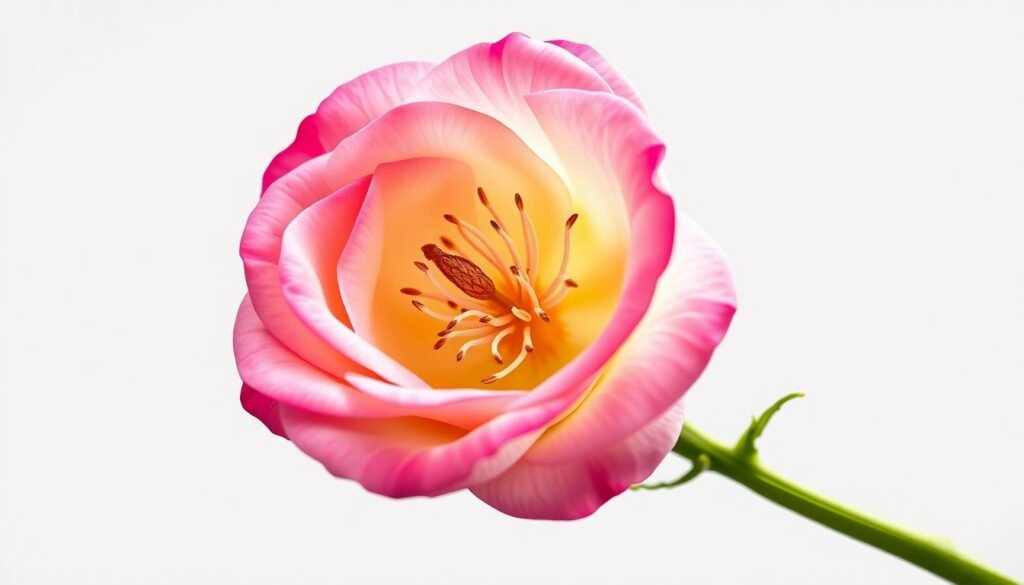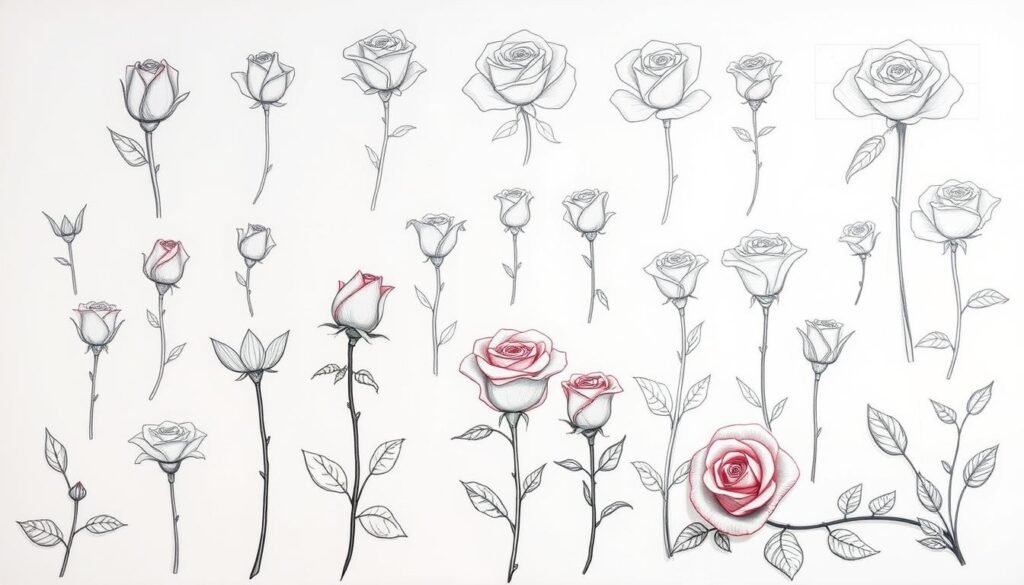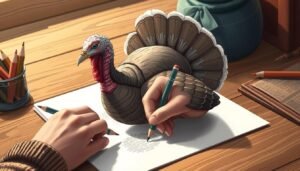Drawing a beautiful rose might seem hard at first. But with the right help, it can be fun and rewarding. Roses are timeless symbols of art. Learning to draw them can boost your artistic skills.
I’ll show you how to make a stunning rose drawing. We’ll start with basic shapes and end with the final details. With patience and practice, you’ll make your rose come alive.
Key Takeaways
- Learn the basic shapes and proportions needed to draw a realistic rose.
- Understand the techniques for creating texture and depth in your rose drawing.
- Discover tips for adding details and finishing touches to your artwork.
- Practice drawing roses with ease and confidence.
- Improve your overall drawing skills with this comprehensive guide.
Introduction to Rose Drawing
Drawing a rose is more than just copying its look. It’s about capturing its essence and beauty. As we explore this, you’ll see that rose drawing is a skill you can learn with practice and patience.
First, knowing how to draw is key to a realistic and beautiful rose. Drawing skills help you show the rose’s detailed features and right size.
The Importance of Drawing Skills
Improving your drawing skills is vital for rose drawing. It means mastering perspective, proportion, and detail. With these skills, your drawings will look more real and pleasing.
For example, drawing the rose’s petals accurately is crucial. It makes your drawing look more realistic.
Overview of the Drawing Process
Drawing a rose involves several steps. It starts with sketching the basic shape and then adding textures and shading. Understanding the rose’s anatomy and breaking it down into simple shapes helps you draw it well.
As we go on, I’ll give you more details on each step. This will help you improve your skills and make beautiful rose drawings.
Necessary Materials for Drawing a Rose
To draw a beautiful rose, you need the right materials. You’ll want to pick drawing tools that help you get the details and texture right.
Recommended Pencils and Paper
Choosing the right pencils and paper is key for a rose drawing. Use HB pencils for basic sketches and 2B or 4B for shading. For paper, go for hot-pressed paper for its smooth finish, perfect for detailed work.
Optional Tools to Enhance Your Art
While pencils and paper are basic, some tools can make your rose drawing better. A blending stump or tortillon can smooth out shading. A kneaded eraser is great for fixing mistakes and adding highlights. For more tips, check out https://www.art-is-fun.com/how-to-draw-a-rose.
- Blending stump or tortillon for smoothing shading
- Kneaded eraser for correcting mistakes and creating highlights
- Sharpener for maintaining pencil sharpness
Understanding Rose Anatomy
Learning about rose anatomy can improve your drawing skills. To draw a rose well, you need to know its structure. A rose has several important parts that make it look beautiful.
Key Parts of a Rose
A rose has many parts, each adding to its look. The petals are the colorful parts that make up most of the rose. The sepals are green and protect the flower bud. The stem holds the rose up, and the leaves grow along the stem and help with photosynthesis.

Different Rose Varieties to Consider
Roses vary in shape, size, and color, each with its own traits. You might draw hybrid teas, floribundas, or climbers. Hybrid teas have big, single flowers, while floribundas have clusters of flowers. Knowing these varieties helps you pick the right rose to draw.
| Rose Variety | Description | Characteristics |
|---|---|---|
| Hybrid Tea | Large, single blooms | Elegant, long stems |
| Floribunda | Clusters of flowers | Vibrant, abundant blooms |
| Climber | Long, trailing stems | Perfect for trellises or arbors |
Understanding rose anatomy and varieties helps you draw more realistic roses. Whether you’re drawing a hybrid tea or a floribunda, knowing the parts and traits of the rose brings its beauty to life on paper.
Sketching the Basic Shape of the Rose
The foundation of a great rose drawing starts with accurately sketching its basic shape. This first step is key. It sets the stage for the whole artwork, affecting both the proportions and the look.
Starting with Simple Shapes
To start, break down the rose into simple shapes. A rose can be shown with circles, ovals, and gentle curves. Start with a large circle for the center of the rose, showing the tightly packed inner petals. Then, use ovals or teardrop shapes for the larger outer petals. This makes drawing the rose easier.
Guidelines for Proportions
Keeping the right proportions is key for a realistic rose drawing. The proportions can be broken down into several key measurements:
| Component | Proportion | Description |
|---|---|---|
| Center Circle | 1/3 of total diameter | Represents the tightly packed inner petals |
| Outer Petals | Variable, based on rose variety | Can be larger and more spread out |
| Stem and Leaves | Proportionate to the rose size | Should be in harmony with the rose |
By following these guidelines and starting with simple shapes, you can create a well-proportioned and beautiful rose drawing. The key is to be patient and take your time during the initial sketching phase.
Adding Detail to Your Rose Sketch
Now that you have the basic shape of the rose, it’s time to add more detail. This step makes your drawing come alive. You’re not just filling in the outline; you’re making the rose look more real.
Defining Petals and Leaves
It’s important to define the petals and leaves for a realistic rose. Start by sketching the soft curves of the petals. Notice how they fold and overlap. For the leaves, focus on their shape and how they surround the stem. Accurate observation is key to get them right.
When you’re refining these details, think about the delicate balance between petals and leaves. How they work together can make your drawing look real. For more tips on drawing roses, check out this step-by-step guide.

Enhancing Texture with Line Work
Line work is key for adding texture to your rose drawing. Varying the thickness and direction of your lines can show the softness of petals and the roughness of the stem. Experiment with different line weights for a more interesting effect.
Artist and instructor
“The quality of your line work can elevate your drawing from a simple sketch to a detailed piece of art.”
So, spending time on line work will really improve your rose drawing.
Shading Techniques for Realism
To make your rose drawing come alive, you must learn about shading techniques. Shading adds depth and dimension, making your drawing look more real and interesting.
Shading means creating different tones and values to show how light affects the subject. In rose drawing, it helps show the petals’ shape, the leaves’ texture, and the flower’s form.
Choosing Your Light Source
First, decide where your light source is. The light’s direction and strength greatly affect your drawing’s shading. For example, a bright light from one side can make shadows deep on the other side. A light that spreads out evenly can make shading softer.
Choosing a light source also affects the mood of your drawing. A strong light can make things look tense, while a gentle light can make them look calm.
Methods for Effective Shading
There are many ways to shade in rose drawing. Hatching is one, where you draw close lines that follow the subject’s shape. Changing the line’s density and direction can create different shading effects.
Another method is cross-hatching, where you layer lines at different angles for a detailed look. Stippling, using small dots, can also make shading detailed and contrasty.

By learning these shading techniques and picking the right light source, you can make your rose drawing look more real and engaging.
Coloring Your Rose: Color Theory Basics
Coloring your rose drawing is more than just filling in lines. It’s about learning color theory to make stunning art. You’ll see how colors work together and how to pick the right ones for your drawing.
The color wheel is key to color theory. It shows colors in a circle, showing their connections. For a rose drawing, pick colors that go well together, like those next to each other or opposite each other on the wheel.
Selecting the Right Color Palette
Picking the right color palette is vital for your rose’s look. Think about the mood you want to show. Soft pastels can be romantic, while bold colors can add energy.
Remember, roses come in many colors like pinks, whites, reds, and purples. Look at real roses or photos for ideas. Trying new color mixes can make your art unique.

Techniques for Blending Colors
Blending colors adds depth to your rose drawing. There are ways to smoothly mix colors. Layering is one, where you build up colors slowly.
Wet-on-wet works well with watercolors or paints. It means adding wet color to wet paper for natural blending. For pencils or pastels, use soft strokes and blending tools.
For more tips on coloring roses, check out this tutorial. It shows how to paint roses step by step.
Learning color theory and blending techniques can make your rose drawing pop. With the right colors and smooth transitions, your art will stand out.
Common Mistakes to Avoid
To make a stunning rose drawing, it’s key to know and avoid common mistakes. These mistakes can ruin your artwork’s quality. Knowing them helps you make a balanced and beautiful drawing.
When drawing a rose, you’ll face challenges that can mess up your work. Two big mistakes are overworking your sketch and ignoring proportion.
Overworking Your Sketch
Many artists make the mistake of overworking their sketches. This makes the drawing look too complicated and lose its freshness. To avoid this, know when to stop and consider your drawing complete.
“The goal of art is to create something that is not just visually appealing but also tells a story or evokes emotion. Overworking can sometimes detract from this goal.”
To stop overworking, set a limit on how many times you revise your drawing. This keeps your rose drawing simple and elegant.
Neglecting Proportionality
Another big mistake is neglecting proportionality. Making sure all parts of your rose are in proportion is key for a realistic look. Check your drawing regularly to ensure it’s in scale.
| Part of the Rose | Proportionality Guideline |
|---|---|
| Petals | Ensure they are not too large or too small compared to the rest of the rose. |
| Stem | Make sure it’s proportional to the size of the rose. |
| Leaves | Check that they are in scale with the petals and stem. |
By being careful with these common mistakes, you can make a beautiful and realistic rose drawing.

In conclusion, avoiding overworking and keeping proportionality in mind are crucial for a stunning rose drawing. Follow these tips to create artwork that looks great and is well-made.
Bringing Your Rose to Life
Bringing your rose drawing to life is more than just the rose. It’s about the background and how you present it. A good background can make your rose look even more beautiful. A professional-looking frame can add a special touch to your artwork.
Adding Background Elements
When adding background elements, aim to complement your rose without taking over. You can pick a simple, neutral background or something more detailed, based on your vision. Think about the mood you want to create: a soft background can be calming, while a textured one adds depth.
For ideas on beautiful backgrounds, check out rose drawing guides. They often share tips on making your artwork stand out.
Framing Your Artwork
Framing is the last step in showing off your rose artwork. The right frame can protect your art and make it look even better. Choose a frame that matches the style and color of your rose and background. For example, a simple black or white frame can contrast well, while a wooden frame adds warmth.
As Bob Ross said, “We don’t make mistakes, just happy little accidents.” When framing, don’t be afraid to try different frames until you find the perfect one for your rose drawing.
“The right frame can turn your artwork into a masterpiece.”
By focusing on background elements and framing, you can make your rose drawing come alive. You’ll end up with a beautiful piece of art that you’ll be proud to show off.
Tips for Practicing Rose Drawing
The secret to drawing stunning roses is practicing regularly. It’s all about getting the hang of rose anatomy and honing your drawing skills. With consistent effort, you’ll get better at drawing roses that look real.
Start by adding daily sketching routines to your schedule. Dedicate a time each day to draw roses. Begin with the basic rose shape and then move on to petals and leaves.
Daily Sketching Routines
Having a daily sketching routine boosts your observation and hand-eye skills. Start with short sessions, like 15-20 minutes a day. As you get better, you can draw for longer periods.
- Start with simple shapes to grasp the rose’s structure.
- Practice drawing different rose parts, like petals and leaves.
- Try out different shading techniques to make your drawings look more realistic.
For detailed tips, check out step-by-step rose drawing tutorials. They offer detailed instructions and helpful advice.
Finding Inspiration from Nature
Nature is a treasure trove of inspiration for artists. Looking at real roses can teach you about their shape, color, and texture. Visiting gardens or looking at rose photos can spark your creativity and offer valuable insights.
“The world is full of wonderful things you haven’t seen yet. Keep your eyes open, and you will discover more and more.” – This quote highlights the importance of observing and staying inspired by the world around us.
By practicing regularly and drawing inspiration from nature, you can improve your rose drawing skills. Remember, mastering rose drawing is a journey. Stay committed to your practice, and you’ll see great results.
Showcasing Your Finished Rose Artwork
After finishing your rose drawing, it’s time to share it with others. Showing your art boosts your confidence and lets you get feedback. It also inspires others with your creativity.
There are many ways to show off your rose artwork. You can display it at home or share it online. Let’s look at some top ways to display and share your art.
Best Ways to Display Art
Displaying your rose artwork at home or in the office is a great way to show your talent. Here are some tips:
- Choose a frame that matches your drawing’s style and colors.
- Make sure the room’s lighting highlights your artwork well.
- Use a strong easel or hanging system to display your framed art.
For a more professional look, think about showing your art in local exhibitions or competitions. This can help you reach more people and get recognized in the art world.
| Display Method | Benefits |
|---|---|
| Home Display | Personal satisfaction, easy to change or update |
| Local Art Exhibitions | Professional exposure, potential for sales or recognition |
| Online Galleries | Global visibility, easy to share with a wide audience |
Sharing on Social Media Platforms
Social media is a great way for artists to show their work. Sites like Instagram, Facebook, and Pinterest are perfect for sharing your rose artwork worldwide.
Here are some tips for sharing on social media:
- Post high-quality images of your artwork.
- Write a catchy description or caption for your artwork.
- Use relevant hashtags to make your posts more visible.
By showing your rose artwork both in person and online, you can share your creativity. This might open up new opportunities in the art world.
Conclusion and Encouragement
As we wrap up this guide on drawing a beautiful rose, take a moment to think about our journey. We’ve covered everything from learning about rose anatomy to showing off your artwork. Remember, the creative process is essential for getting better at drawing.
Persisting Through Practice
Keep practicing and honing your skills to make stunning rose drawings. With every try, you’ll see your ability to detail and capture the rose’s beauty grow.
Growing as an Artist
Keep moving forward in your artistic journey. Growth and improvement take time. Stay dedicated, and you’ll be surprised at how far you’ve come. The creative process is rewarding, bringing joy and fulfillment.





















